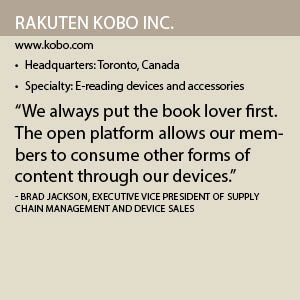Rakuten Kobo
But Kobo offers its customers other convenient features. It sells e-readers that are waterproof, offers adjustable lighting for day and night reading and larger–than-average screen sizes.
“If you look back over time, you’ll see that Kobo tends to be a trend leader with these features and the market quickly follows,” says Brad Jackson, executive vice president of supply chain.
Trend Setters
Kobo offers three categories of e-reader products that range in price from $119 for an entry-level device to $229 for a premium device. “We have a number of exciting considerations in our future lineup that will continue to evolve our e-reader devices,” Jackson says. “We are continuing to enhance the user experience.”
All devices come with adjustable lighting, but some take it a step higher. For example, the high-end ComfortLight PRO provides the best nighttime reading experience by reducing blue light exposure and emitting an optimal hue based on the time of day, from a white sunlight to an orange candlelight. Users can also choose their own light settings based on your personal preference.
Mid-range and premium devices are also waterproof, a feature that was added in 2014. When it comes to size, Kobo’s entry-level reader’s screen size is 6 inches, a standard in the industry. Its mid-range device is available in 6.8 inches and its premium in 7.8 inches.
“When we design e-readers, we take an innovative approach to bring the best features in the business to our customers,” says Rene d’Entremont, director of public relations. “Not all competitors go as far as we do. We were the first company to come out with waterproofing and to offer blue light reducing front lit displays.”
Jackson says that the company has been tremendously successful with its premium devices thanks to their combination of waterproofing, comfort lighting and screen size. d’Entremont adds that while entry-level devices sell the most in terms of volume, premium devices attract the most-desirable consumer: one that buys a lot of e-books.
Open Platform
Kobo offer a selection of roughly 5 million e-books and audiobooks and sells products in more than 100 languages and 190 countries. “And we’re continuously working with our publishers to enhance our library,” Jackson says.
The company also differentiates itself from competitors by supporting an open-source E-pub format. Unlike many of its competitors, Kobo offers an open platform that allows its e-reader users to download books from a variety of outlets other than itself.
“We always put the book lover first,” Jackson says. “The open platform allows our members to read other forms of content through our devices.”
Kobo also recognizes that not all book lovers want to consume content using an e-reader. In response, the company has developed an app that allows consumers to download books to their tablets and smartphones. The app also offers a number of free e-books.
Reverse Logistics
As the head of supply chain, Jackson is working to improve the consumer experience when it comes to return policy. “We are now doing reverse logistics,” he says. “That’s an area that every retailer has to contend with. It’s a critical aspect of the overall customer experience and we see opportunities to further enhance it.”
It will involve analyzing customer return data to determine areas for improvement. “We will work collaboratively with consumers to understand their needs,” he says.
Founded in December 2009, Kobo’s mission is to empower booklovers to read more. The company is owned by Canadian e-commerce company Rakuten Inc.
